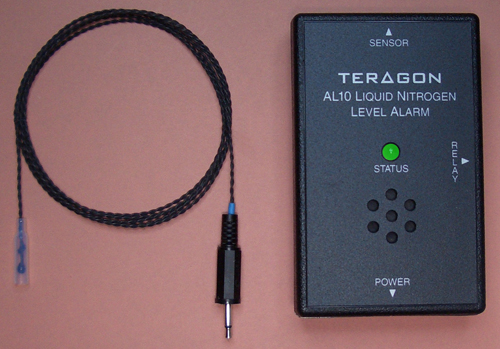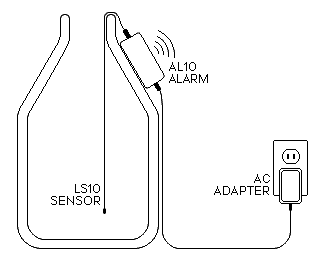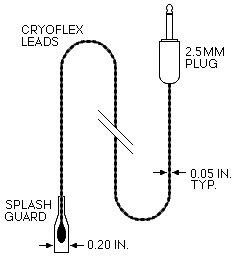AL10 Liquid Nitrogen Level Alarm
The Teragon AL10 Alarm continuously monitors the liquid level in cryogenic reservoirs. The alarm is used to warn of the impending loss of liquid nitrogen. Applications include the protection of cryobiological samples or high-voltage radiation detectors. The AL10 requires no adjustments or calibration and is ready to use as shipped.
 |
The alarm uses a liquid sensor that is placed at the desired alarm level. As the liquid level passes the sensor, the alarm will sound and the 'STATUS' LED will change from green to red. The alarm can be user configured as either a low-level alarm (sensor dry) or a high-level alarm (sensor wet). An internal relay allows the AL10 to activate a remote alarm or auto-dial phone system.

Typical AL10 Application
The AL10's features include:
| Audible and Visual Alarm Signals | |
| High or Low Level Alarms | |
| Sensor Signal Indicator | |
| Relay for External Connection | |
| Small Size | |
| Low Cost | |
| Easy Installation (No Calibration Adjustments) | |
| 1 Year Warranty | |
| Made in the USA |
U.S. Pricing
The AL10 system comes with the alarm module, level sensor, AC power adapter, velcro mounting strips, and a user guide. Sensors are available in lengths of 2, 3, and 4 feet (please specify the desired sensor length). All parts are covered by a 1 year warranty.
- AL10 alarm system: $695
- LS10 replacement sensor (2, 3 or 4 foot lengths): $150
- SX10 Non-cryogenic sensor extensions (6 foot): $115
- Prices are FOB San Francisco and are subject to change.
- LS10 replacement sensor (2, 3 or 4 foot lengths): $150
Download the AL10 User Guide
AL10 Specifications
Power Supply: 9-12 VDC @ 0.1 Amp
Power Jack: 2.1 mm x 5.5 mm, Center Positive
Audible Tone: 2000 Hz, 88 dBA @ 10 cm
Visual Indicator: Tri-Color LED
Alarm Dimensions: 3.63 in. x 2.28 in. x 1.11 in.
Sensor Type: Teragon LS10 (Thermally biased Teristor)
Sensor Bias: 44 mW @ 78 Kelvin
Sensor Lengths: 2, 3, or 4 feet
Alarm Relay: SPST, 0.5 Amp @ 12 VDC
Relay Jack: 2.5 mm x 5.5 mm
Specifications are subject to change without notice.
Application Notes
The LS10 sensor, shown below, detects the different thermal conductivities of liquid and gaseous nitrogen. This is done by biasing the sensor with a small amount of heat input (44 mW). If the sensor is submerged in LN2, the heat is conducted away from the sensor with negligible temperature rise. However, if the sensor is uncovered, a small but measurable temperature rise occurs at the sensor tip.

The LS10 Liquid Nitrogen Sensor
The AL10 alarm analyzes the sensor signal to determine if an alarm condition exists. (The alarm can be configured as either a high- or low-level alarm by a jumper on the AL1 circuit board.) During normal operation (no alarm condition) the 'STATUS' LED will be green. When an alarm condition occurs, the AL10 will: (1) change the 'STATUS' LED to red, (2) sound the audible alarm and (3) actuate the alarm relay. The AL10 will also sound the alarm if the sensor is unplugged or damaged. In this case, the 'STATUS' LED will blink red.
The alarm relay, accessible via an electrical jack on the side of the alarm module, allows the AL10 to interface with external equipment. A jumper on the AL10 circuit board allows the relay to operate in one of two modes: either conventional or fail-safe. In the fail-safe mode, the alarm condition is signaled by open relay contacts. The relay is closed only when there is no alarm. If power is removed from the AL10, the relay will open to indicate a potential hazard. In the conventional relay mode, the alarm condition is signaled by closed relay contacts. The relay is open when there is no alarm condition or if power is removed from the AL1.
The small size of the AL10 alarm permits it to be mounted on the side of monitored dewars. This is easily done using the adhesive-backed velco strips provided with the AL10. The position of the mounting can be chosen so that the sensor will freely hang at the desired alarm height (see diagram above). An integral splash guard on the end of the sensor inhibits premature triggering in applications involving turbulence.
|
. |
|
Teragon Research 2518 26th Avenue San Francisco, CA 94116 |
|
Copyright © 2025 E-mail: sales@trgn.com Phone: 415-664-6814 |